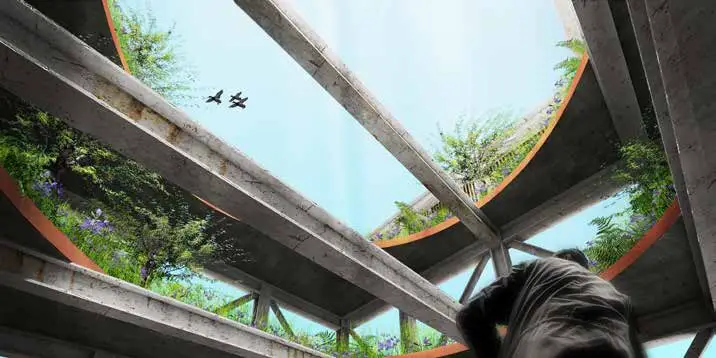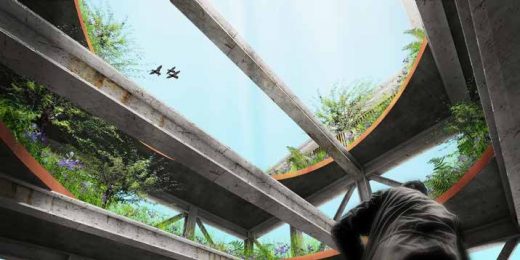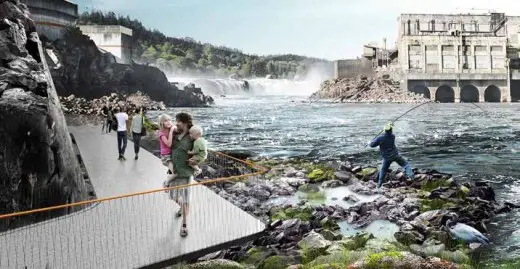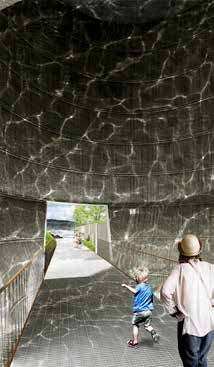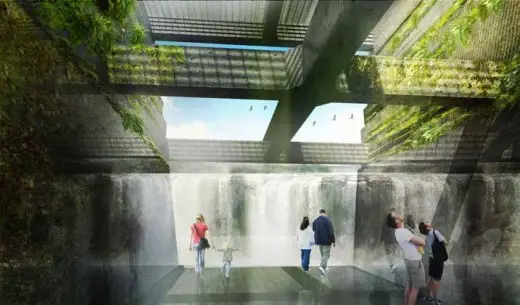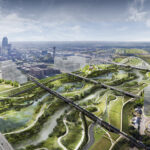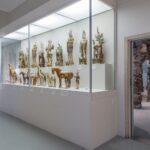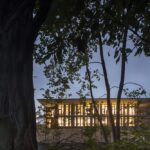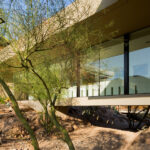Willamette Falls Riverwalk, Oregon Public Architecture Images, US Landscape design, OR second largest waterfall
Willamette Falls Riverwalk
Contemporary Landscape Development in Oregon design by Mayer/Reed, Snøhetta and DIALOG
Jun 3, 2015
Design: Mayer/Reed, Snøhetta and DIALOG
Location: Portland, Oregon, USA
Design Team Chosen for Iconic Willamette Falls Riverwalk Project
The Riverwalk will allow people access to Willamette Falls, the second-largest waterfall in the U.S. by volume, for the first time in 100 years.
Willamette Falls Riverwalk in Oregon
Oregon Governor Kate Brown announced the selection of the design team for the Riverwalk portion of the Willamette Falls Legacy Project today, ushering in the next step in the redevelopment of a significant landmark site near the country’s second largest waterfall. The team of Mayer/Reed, Snøhetta and DIALOG were chosen after an extensive national proposal process conducted this Spring, and will begin work this summer on the schematic design of the Riverwalk. When completed, the project will open Willamette Falls to the public for the first time in over 100 years.
Local and regional elected officials and community supporters praised the selection of the team on Friday.
“This is the first step in rediscovering one of Oregon’s most beautiful and significant places,” said Carlotta Colette, Metro Councilor. “We are going to allow people to see Willamette Falls in a way they haven’t been able to experience it for more than a century and create housing, jobs, and public spaces at the same time.”
“I am excited that we have chosen an extraordinary team to help create a world-class Riverwalk to Willamette Falls,” said Oregon City Mayor Dan Holladay. “Providing public access to the Falls will not only allow the public to return to an amazing section of the Willamette River in Oregon City, but will also drive economic investment into the Blue Heron property and surrounding area. “
“Clackamas County is a proud partner and a firm believer in this project’s future potential for our county and for our region,” said Clackamas County Commissioner Tootie Smith. “Through this collaborative partnership, great progress has been made toward transforming this site and capitalizing on its historic, cultural and economic significance.”
The selection process invited design teams to demonstrate their approach to give the public access to the breathtaking Willamette Falls and the adjacent industrial site. Mayer/Reed, Snøhetta, and DIALOG envisioned an experientially-rich Riverwalk that not only accesses and amplifies the magnetic power of the Willamette, but also courses through time, stitching together the natural and cultural histories embedded within the Blue Heron site.
“We believe that the site and the history it holds is a sublime, one-of-a-kind landscape that should not be upstaged by the hand of any designer,” commented Michelle Delk, Snøhetta’s Director of Landscape Architecture. “We are inspired by the complex strata of the site and its deep cultural history. By protecting, reusing, reducing, and adding, we will integrate and amplify the site’s strata into the Riverwalk,”
Located at the end of Main Street in Oregon City, the current Willamette Falls Legacy Project site is a cluster of empty industrial buildings, the remnants of the Blue Heron Paper Mill, which was shuttered in a bankruptcy in 2011. The Willamette Falls Legacy Project is a collaboration of four public sector partners (Metro, the Portland-area regional government, the City of Oregon City, Clackamas County and the state of Oregon) and the Blue Heron site’s landowner, Falls Legacy LLC. The project aims to create a Riverwalk that connects people to the falls as well as a Willamette Falls Downtown District with spaces for housing, employers and recreation.
“The upland portions of the site will thrive when their connectivity to the water’s edge, their form, massing and sight lines, and indeed the very fabric of uses eventually embedded in the site, are carefully considered together,” notes Alan Boniface, DIALOG Principal.
Long an important gathering spot and fishing location for Native American tribes, Willamette Falls was also a final destination for many a westward-heading pioneer due to its location at the end of the Oregon Trail. It was also site of the country’s first long-distance transmission of electricity in 1889, when electricity generated by the falls was sent several miles away to Portland. Throughout the 19th and 20th centuries, it was the site of various thriving industries, including lumber, flour, woolen, and paper mills, and a brick-making operation.
“The magnetism of Willamette Falls is the genesis and spirit of place. We will provide an experiential glimpse of the fall’s power, one that transports visitors deep into history and highlights its ephemeral qualities” says Carol Mayer-Reed, Principal of Mayer/Reed.
The design team’s approach showed the falls and the complex material layers of the site as a portal to the Northwest’s collective history. The site’s strata tells the story of deep geology, dynamic hydrology, and vibrant ecology, together forming the spirit of place.
It tells the story of Native Americans who first understood the site’s promise, fishing its waters and building deep tradition, as well as that of European immigrants who claimed Oregon City, carving out a grid and building settlements. It tells the story of workers and industrialists who ground flour, drove timber, spun wool, milled paper, and generated electricity. It will tell the story of you – the public – who will help lay down the next historic layer – an experiential riverwalk, foretelling a story of renewed economy, environmental sensitivity, and historic importance.
The idea boards and images generated by the design team demonstrate their thinking and approach to the site. The final design for the new Riverwalk will be the result of an extensive public engagement process.
Snøhetta and Mayer/Reed are also currently working on Portland’s James Beard Public Market. DIALOG brings international experience designing revitalized post-industrial waterfronts and will provide urban design expertise on the project. DIALOG and Snøhetta are also working together on the Calgary Central Library in Alberta, Canada, currently under construction.
Willamette Falls Riverwalk in Oregon information / images received 03062015
Willamette Falls Riverwalk in Oregon features in ‘Snøhetta: People, Process, Projects’ Exhibition, April 17 – June 30, 2016, at The Center for Architecture, Portland, OR.
Location: Willamette Falls, Portland, Oregon, USA
Oregon Building Designs
Trout Lily Screen Porch Trout Lily Vineyard, Newberg, Yamhill County, Oregon
Design: beebe skidmore architects
Trout Lily Screen Porch
Western USA Building Designs
Contemporary Western United States Architectural Designs – recent selection from e-architect:
The Society Hotel, Washington
Design: ONOMA ARCHITECTURE with Delta Architects
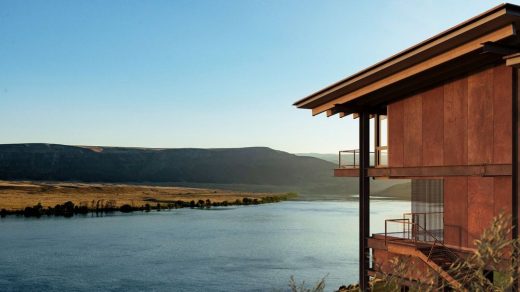
rendering : Notion workshop
West Bar, Washington State
Flathead Valley Community College, Kalispell, Montana, Kalispell, Montana, Western United States of America
Design: Cushing Terrell
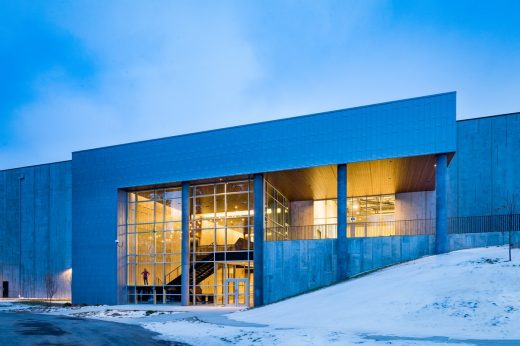
photo : Heidi Long, Longviews Studios
Flathead Valley Community College, Wachholz College Center
United States Architectural Designs – recent selection from e-architect:
Comments / photos for the Willamette Falls Riverwalk in Oregon design by Mayer/Reed, Snøhetta and DIALOG page welcome
Website : Mayer/Reed
Website : Snøhetta
Website : DIALOG

